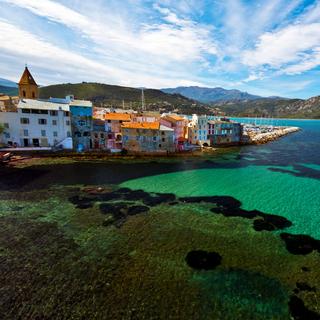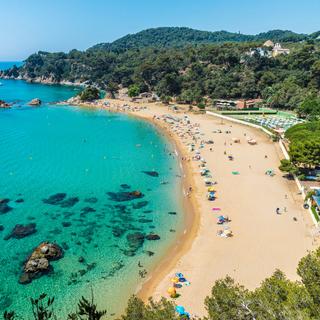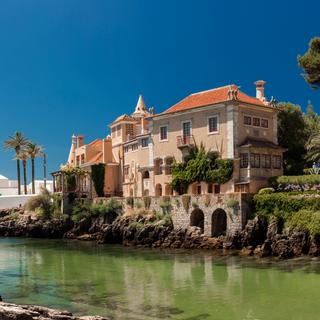
Sintra weather and climate

Sintra weather and climate
Day
24 °C
Night
16 °C
Sea
19 °C
Precipitation
8 mm
in month
Rainy days
1 days
in month
Daylight
14 hours
average
Sunshine
11 hours
average
Humidity
64 %
Weather charts for Sintra
Destinations nearby and activities
Destinations nearby
Activities in Sintra

Find more destinations like this
Destinations with similar weather to Sintra
Other destinations in Central Portugal
Closest cities for Sintra
Weather overview for Sintra
Weather overview
Situated in Portugal, the picturesque town of Sintra is renowned for its warm climate with the temperature during the day oscillating between 14 °C (57 °F) in January to a pleasant 24 °C (75 °F) in August. Visitors can enjoy the highest sea temperatures during August reaching up to 19 °C (66 °F) while the coldest sea waters can be found in February, showing a temperature of 14 °C (58 °F). Additionally, July stands out as the most arid month, with an average of just 1 day experiencing rainfall. In contrast, the most precipitous month is November, where one can expect up to 11 days of rain. Nightly temperatures vary as well, starting from 8 °C (46 °F) in January and increasing to 16 °C (61 °F) in August.
January weather
In January, the sea temperature in Sintra is noted at 15 °C (59 °F), alongside a daytime temperature low of 14 °C (57 °F). The onset of the decrease in rainy days is indicated by an average of 10 days, paralleled by a decrease in the total rainfall amount, registering at 89 mm (3.51 in). The coldest night temperatures are observed, sitting at 8 °C (46 °F), while the lowest wind speeds are recorded, averaging 4.
February weather
The upward trend in daily temperatures begins in February with a figure of 15 °C (59 °F), while the sea temperature reaches its lowest point of the year. The decline in precipitation continues with a recorded 78 mm (3.08 in). Night temperatures see a marginal increase to 9 °C (47 °F). The climb in cloudless sunshine hours starts at 5 hours.
March weather
A consistent rise in Sintra's day temperature is seen in March, recorded at 17 °C (63 °F), with the nocturnal temperature also on an upward trajectory, at 10 °C (50 °F). The frequency of rainy days begins to diminish, marked by 7 days, and the rain volume continues its downward trend, now at 52 mm (2.06 in). Sunlight hours, free from cloud cover, keep on increasing, reaching 7 hours.
April weather
April showcases a continued increase in sea temperature in Sintra, now at 15 °C (59 °F), and daytime temperature trends higher as well, registering at 18 °C (64 °F). The number of days with rainfall slightly ascends to 9 days, and the volume of rain starts to rise incrementally, recorded at 64 mm (2.51 in). Clear hours of sunshine rise as previous months, notched at 8 hours. Night temperatures further escalate, now at 11 °C (52 °F).
May weather
With the advance of May, the sea temperature in Sintra pursues its rise, arriving at 16 °C (61 °F), while daytime warmth continues its upward path, attaining 20 °C (67 °F). Noticeable is the initial decrease in the count of rainy days, dropping to 6 days, coupled with the onset of reduced rainfall, now at 49 mm (1.94 in). Further increment in nocturnal temperatures is marked, reaching 13 °C (55 °F). The momentum of sunlit hours remain ascending, recorded at 9 hours.
June weather
June experiences a continuation of the upward pattern in day temperatures, now at 22 °C (72 °F), and a concurrent rise in sea temperatures, reaching 18 °C (64 °F). The downward trend in the number of rainy days is apparent, tallying at 3 days, and rainfall volume is on a continuous fall, with a sum of 16 mm (0.63 in). Daylight reaches its peak for the year, calculating at 15 hours. Night temperatures keep elevating, now charted at 15 °C (59 °F).
July weather
July marks the start of the high tourist season in Sintra. The ocean temperature makes comparable progress to previous months, now at 18 °C (65 °F), and daily temperatures pursue their upward climb, drawing to 24 °C (74 °F). Notable is the drop in rainy days to a minimum, situated at 1 day, along with a nadir in precipitation, falling to 5 mm (0.20 in). Maximum levels of cloud-free sunshine hours are observed, tallying at 11 hours.
August weather
August stands as the time of year when the day temperature reaches its high point, noted at 24 °C (75 °F), and the sea temperature peaks as well in Sintra. The tourist season and dry spell approach their zenith, while the lowest humidity levels are marked, at 64 %. Nighttime temperatures hit their maximum, attained in August.
September weather
September participates in the tourist and dry seasons. The commencement of the dip in daytime temperatures is perceptible, now at 23 °C (73 °F), and night temperatures start their descent as well. The surge in the number of days with rainfall is noticeable, alongside the initial increase in rainfall volume.
October weather
As October arrives, the waning of sea temperatures becomes evident in Sintra, paralleled by a continuance in the drop of daytime warmth, marked at 21 °C (69 °F). The trend in rainy days augments further, and so does the volume of precipitation, observed at 92 mm (3.63 in). Night temperatures go on a similar descending path, now at 14 °C (57 °F). The span of sunny hours maintains its decrease.
November weather
In November, Sintra observes a comparable decrement in sea temperatures, established at 17 °C (62 °F), with daytime temperatures also in decline, posted at 17 °C (62 °F). A zenith in rainfall volume is distinct, charting 114 mm (4.50 in), along with the climax of rainy days for the year. Bright hours decrease consistently as they have in previous months, marked at 5 hours. The downward trajectory of nocturnal temperatures is clear, registering 11 °C (52 °F).
December weather
December's data express a persistence in the drop of day temperatures, now at 14 °C (58 °F), and a discernible decrease in ocean temperatures, placing it at 16 °C (60 °F). The decline in night temperatures proceeds as in prior months. The shortest daylight span is seen in this month. Scarce are the bright hours of sunshine in December.
FAQs
What is the lowest wind speed noted in Sintra during January?
In January, Sintra experiences a mild breeze with wind speeds averaging a low of 4
How much does the night temperature increase in February compared to January?
Night temperatures in Sintra experience a slight rise in February, going up to 9 °C (47 °F) from January's 8 °C (46 °F).
Does the length of cloud-free sunlight hours increase in March?
Yes, March in Sintra brings a growth in sun-filled hours, with an average of 7 hours per day.
Is there a significant increase in rainfall during April?
April sees a modest resurgence in rainfall in Sintra, both in terms of rainy days at 9 days and total rainfall amounting to 64 mm (2.51 in).
How does the rainfall compare in May to the previous months?
May introduces a decline in rainfall in Sintra, with rainy days decreasing to 6 days and total rainfall hitting 49 mm (1.94 in)
How many hours of daylight does Sintra receive at its peak in June?
At its summertime apex, Sintra savors an extensive 15 hours of daylight.
Does Sintra's tourist season coincide with the minimum rainfall in July?
Indeed, the peak of Sintra's tourist season aligns with the least amount of rainfall, averaging a mere 1 day.
Is the humidity in Sintra considerably low during August?
Sintra witnesses its lowest humidity levels in August, descending to 64 %
Do night temperatures in Sintra start to decline in September?
Yes, September sees a downturn in Sintra's night temperatures.
Is there a noticeable increase in wet weather during October?
October brings a visible advancement in Sintra's wet conditions, with more rainy days and a higher precipitation totalled at 92 mm (3.63 in).
What are the chances of experiencing rain in November in Sintra?
November offers the highest likelihood of rainfall in Sintra, with the climax of rainy days peaking during this month.
Is December the month with the shortest daylight hours in Sintra?
Certainly, December in Sintra is characterized by the brevity of its daylight hours.











